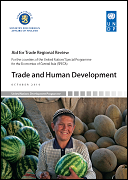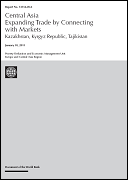Trade
While exhibiting significant differences, the Central Asian countries face a number of common trade and human development challenges. Several of these challenges have been highlighted or aggravated by the recent economic crisis. Trade, in particular, has declined owing to lower demand in key markets, lower commodity prices, a drop in remittances and other foreign inflows, and trade finance difficulties. Countries in the region have taken short-term measures to deal with the challenges mentioned, but the longer-term development of the region would benefit from concerted actions to increase trade in a way that contributes to human development.
There are considerable untapped potential for trade diversification and trade development both within the region and with the rest of the world. The main obstacles for developing this potential include a number of institutional impediments to trade, and the unfavourable geography of the countries.
In the short term, trade development opportunities should be exploited through targeted development of specific sectors with recognised export potential, combined with measures for raising quality standards and improving input efficiency.
In the medium and long term, harmonised trade policies, trade facilitation, institutional and regulatory development, continued product and market diversification, and improvement of business conditions would allow new sectors and enterprises to develop in response to future shifts in local and international demand, thus sustainably contributing to human development.


